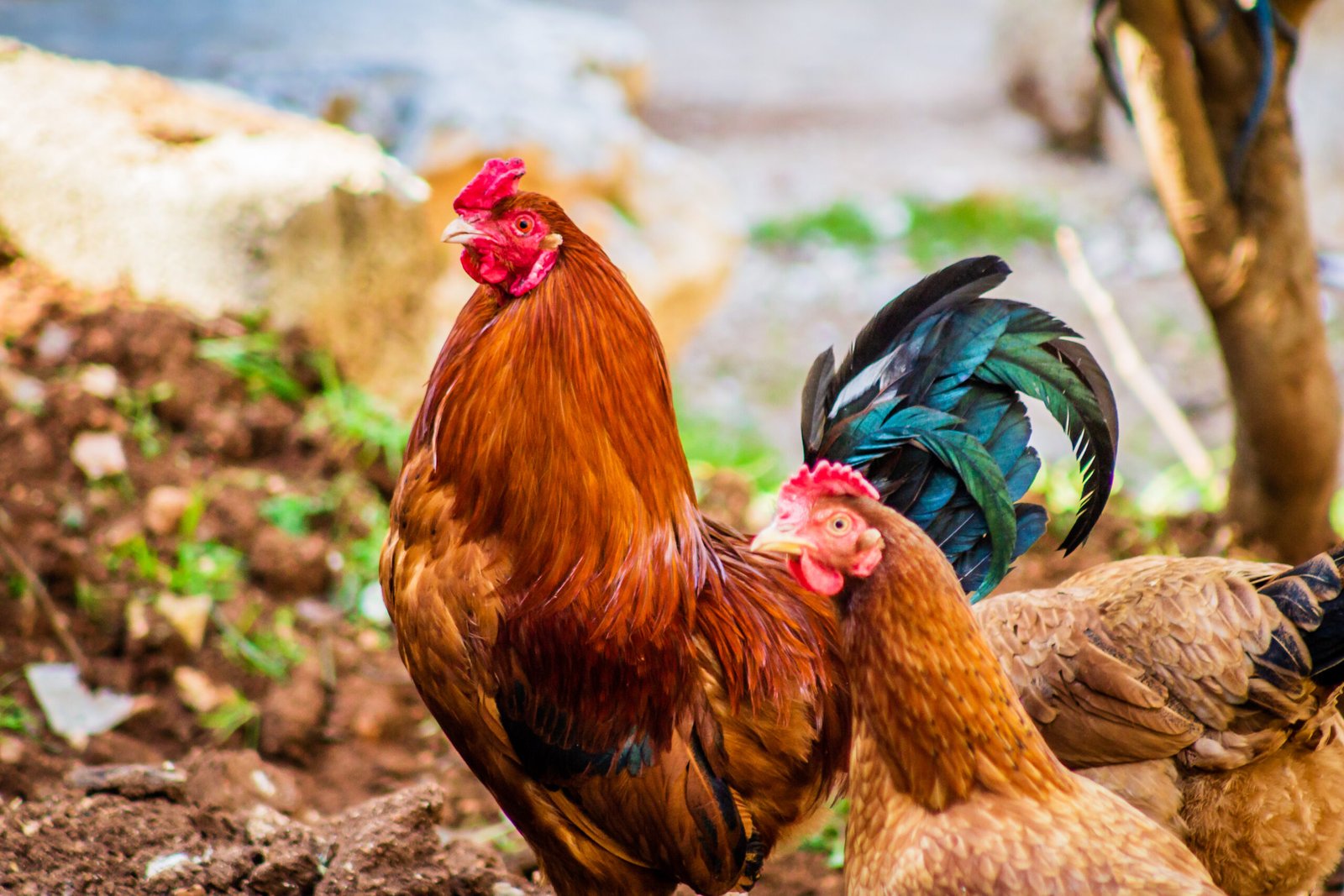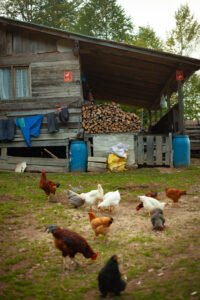
In a bustling flock of young roosters, managing aggression becomes a crucial endeavor. But fear not, for there are effective techniques to ensure a harmonious and peaceful environment for these feisty feathered friends. This article will explore practical strategies and helpful tips to navigate the challenges and channel the vibrant energy of young roosters towards a cooperative and amicable coexistence. With a dash of patience and a sprinkle of understanding, you’ll be well-equipped to foster a friendly and tranquil flock.

Understanding Aggression Among Young Roosters
Owning and raising roosters can be a rewarding experience, but it’s important to understand and manage aggression among young roosters. Aggression is a natural behavior in roosters, as it stems from their natural instinct to establish dominance and protect their territory. However, excessive aggression can lead to injuries and harm to other birds in the flock. By understanding the nature of rooster aggression, recognizing aggressive behavior, and implementing appropriate strategies, you can create a harmonious living environment for your young roosters.
The Nature of Rooster Aggression
Rooster aggression is influenced by various factors, including genetics, hormones, and social interactions. It’s important to note that aggression is more common among certain breeds and individual roosters. Some roosters may have a predisposition to be more aggressive due to their genetic makeup. Hormonal changes during adolescence can also contribute to an increase in aggression among young roosters. Additionally, competition for resources, such as food, water, and mates, can fuel aggression. Understanding these underlying factors can help you better manage and prevent aggressive behavior among your roosters.
Factors That Influence Rooster Aggression
Several factors can influence rooster aggression. Firstly, overcrowding in the flock can lead to increased competition and aggression among roosters. Providing sufficient space and resources is crucial to minimizing aggression. Secondly, the establishment of a dominance hierarchy is important in managing aggression. Roosters naturally establish a pecking order, with the dominant rooster asserting its authority over others. This hierarchy helps reduce aggression by establishing clear boundaries. Lastly, introducing new roosters gradually can help minimize aggression, as sudden introductions can disrupt the existing social dynamics within the flock.
Recognizing Aggressive Behavior in Young Roosters
It’s essential to be able to recognize aggressive behavior in young roosters in order to intervene promptly. Signs of aggression include aggressive posturing, such as puffing up their feathers, raising their necks, and lowering their wings in a threatening manner. Roosters may also engage in physical aggression, such as pecking, sparring, and charging at other birds. Aggressive roosters may exhibit territorial behavior, defending their area from other birds. It’s important to monitor the behavior of young roosters closely and intervene if aggression becomes excessive or poses a risk to the well-being of other flock members.
Creating an Appropriate Living Environment
Providing an appropriate living environment is essential for managing aggression among young roosters. By ensuring they have sufficient space and resources, establishing a dominance hierarchy, and separating aggressive roosters when necessary, you can create a peaceful and balanced flock.
Providing Sufficient Space and Resources
One of the key factors that can lead to rooster aggression is overcrowding. Each rooster should have enough space to establish its territory and feel secure. Aim for a minimum of 10 square feet per rooster in the coop and at least 100 square feet per rooster in the outdoor run. Additionally, providing an adequate number of feeders and waterers can help reduce competition and aggression over resources.
Establishing Dominance Hierarchy
Allowing roosters to establish a dominance hierarchy is crucial in managing aggression. It’s natural for roosters to assert their dominance over others, and establishing a clear pecking order can help minimize conflicts. Be observant of the interactions between roosters and avoid interfering unless the aggression becomes excessive or dangerous.
Separating Aggressive Roosters
If a rooster’s aggression becomes a significant issue and poses a risk to the flock, it may be necessary to separate the aggressive rooster from the rest of the birds. A separate enclosure or bachelor pad can be created for the aggressive rooster to live in temporarily. This separation allows the aggressive rooster to cool down and prevents potential injuries to other flock members. Regular observation should be made to evaluate whether the rooster is showing signs of improvement and can be reintegrated into the flock.

Proper Socialization Techniques
Socialization plays a crucial role in managing aggression among young roosters. By socializing them properly from an early age and introducing new roosters gradually, you can reduce conflicts and promote positive interactions within the flock.
Early Socialization of Young Roosters
From a young age, expose roosters to different social situations and other birds. This early socialization helps them develop social skills and learn appropriate behaviors. Allow them to interact with other chickens, both young and adult, in a supervised and controlled environment. By exposing them to a variety of experiences, you can help them become well-adjusted and reduce the likelihood of aggression later on.
Introducing New Roosters Gradually
When introducing new roosters to an existing flock, it’s important to do so gradually. Sudden introductions can cause stress and territorial disputes, leading to increased aggression. Start by keeping the new roosters in a separate enclosure within sight of the existing flock. Allow them to become acquainted with each other through gradual interactions, such as supervised free-ranging or separated runs that allow visual and auditory contact but prevent physical contact. This gradual introduction gives the roosters time to adjust and establish a new social hierarchy without engaging in aggressive behavior.
Avoiding Overcrowding in the Flock
Overcrowding can exacerbate aggression among roosters. Provide enough space within the coop and run to minimize competition and overcrowding. Each rooster should have ample room to move around and establish its own territory. Overcrowding can also lead to an increased risk of injuries and the spread of diseases. Regularly assess the flock’s size and make adjustments as needed to ensure a healthy and harmonious living environment.
Implementing Behavior Modification Strategies
Behavior modification strategies can help address and redirect aggression among young roosters. By identifying and addressing triggers, utilizing positive reinforcement training, and using distractors to redirect aggression, you can help modify their behavior in a positive and effective way.
Identifying and Addressing Triggers
Observing the circumstances that trigger aggressive behavior in roosters is essential in managing their aggression. Identify any specific situations, objects, or interactions that consistently lead to aggression. Once identified, take steps to minimize or eliminate the triggers. For example, if certain types of feed aggression are triggered during feeding times, consider using multiple feeding stations or providing feeders with dividers to prevent direct competition for food.
Positive Reinforcement Training
Positive reinforcement training can be an effective tool in modifying rooster behavior. Reward desirable behaviors, such as calm and non-aggressive interaction with other birds, with treats or praise. This training helps roosters associate positive outcomes with appropriate behavior, encouraging them to repeat those behaviors. Additionally, redirect any aggressive behavior to a more appropriate outlet, such as pecking at a designated toy or engaging in dust bathing, and reward the redirected behavior.
Using Distractors to Redirect Aggression
Distracting roosters when they display aggressive behavior can help redirect their attention and diffuse potential conflicts. Place objects or toys in the environment that roosters can peck at or interact with, providing an outlet for their aggression. This can help channel their energy into more productive activities and reduce the likelihood of aggression towards other flock members. Experiment with different distractors to find what works best for your roosters.

Utilizing Physical Barriers and Limitations
Physical barriers and limitations can be useful in managing aggression among young roosters. By using rooster fencing or enclosures, temporarily separating roosters, and applying wing clipping techniques, you can ensure the safety of the flock and minimize potential conflicts.
Using Rooster Fencing or Enclosures
Rooster fencing or enclosures can be used to separate aggressive roosters from the rest of the flock while still allowing them to have some freedom and interaction. These enclosures should be secure and provide enough space for the rooster to move around comfortably. They can be used temporarily or as a long-term solution if necessary.
Separating Roosters Temporarily
If a rooster’s aggression becomes extreme, separating it from the rest of the flock temporarily may be necessary. This separation gives the aggressive rooster time to calm down and prevents potential injuries to other flock members. Provide a separate enclosure or a designated area within the existing coop where the rooster can stay until its behavior improves.
Applying Wing Clipping Techniques
Wing clipping is another technique that can limit a rooster’s ability to fly and potentially cause harm. Trimming the primary flight feathers on one wing can create an imbalance and prevent the rooster from achieving a full flight. This technique can be effective in managing aggression, as it restricts a rooster’s mobility and reduces its ability to engage in aggressive behaviors such as charging or chasing other flock members. However, it’s important to learn proper wing clipping techniques and consult with a poultry expert before attempting it.
Considerations for Housing and Roosting
Creating a suitable housing and roosting environment can help reduce aggression among roosters. By providing sufficient roost space, creating visual barriers, and placing food and water separately, you can promote a more peaceful coexistence within the flock.
Providing Sufficient Roost Space
Roosters require adequate space to roost comfortably and establish their hierarchy. Ensure that there are enough roosts available with adequate spacing between them. A general guideline is to provide at least 10 inches of roosting space per rooster. Having enough roosting space allows roosters to establish their preferred perches without feeling crowded or threatened by others, reducing the likelihood of aggression.
Creating Visual Barriers
Visual barriers can help minimize aggressive encounters among roosters. Use dividers or screens to create separate areas within the coop or run. This allows roosters to establish their own territories and limits direct visual contact, which can sometimes provoke aggression. Visual barriers can provide a sense of security and reduce the likelihood of conflicts.
Placing Food and Water Separately
Having separate feeding and watering stations can prevent competition and aggression over resources. Provide multiple feeders and waterers in different areas of the coop or run to accommodate the entire flock. This allows roosters to access food and water without feeling the need to assert dominance or guard the resources. Placing them at different locations also encourages movement and prevents crowding around a single food or water source.
Nutrition and Supplementation
Proper nutrition and supplementation play an important role in managing aggression among roosters. By ensuring a balanced and nutritious diet, avoiding excessive protein intake, and supplementing with natural calming agents, you can support their overall well-being and reduce the likelihood of aggressive behavior.
Balanced and Nutritious Diet
A balanced and nutritious diet is crucial for rooster health and behavior. Provide a well-rounded commercial feed specifically formulated for roosters that meets their nutritional requirements. Ensure the feed contains adequate amounts of essential nutrients, vitamins, and minerals. A balanced diet helps maintain overall health and supports a more balanced temperament in roosters.
Avoiding Excessive Protein Intake
While protein is essential for roosters, excessive intake can lead to increased aggression. Too much protein can cause elevated hormone levels, potentially triggering aggressive behavior. Ensure that the rooster’s diet is not overly rich in protein, and opt for feeds with an appropriate protein content for their age and breed. Consulting with a poultry nutritionist can help you determine the best diet for your roosters.
Supplementing with Natural Calming Agents
Natural calming agents can be beneficial in managing aggression among roosters. Certain supplements, such as herbs, probiotics, or calming essential oils, may help promote a more relaxed and balanced temperament. Consult with a veterinarian or poultry expert to explore safe and appropriate options for supplementation.
Monitoring and Intervention
Regular monitoring of rooster behavior is essential in managing aggression effectively. By observing their interactions, addressing aggression promptly, and seeking veterinary advice if necessary, you can ensure the well-being and safety of your flock.
Regular Observation of Rooster Behavior
Monitor the behavior of your roosters regularly to identify any signs of aggression or changes in behavior. Spend time observing their interactions, both during feeding times and free-ranging activities. Pay attention to any overtly aggressive behaviors, such as chasing, pecking, or fighting. Early detection allows for timely intervention and better management of aggression.
Addressing Aggression Promptly
If you notice any aggressive behavior among roosters, address it promptly to prevent escalation. Intervene by calmly and assertively, but not aggressively, separating the birds involved. Provide distractions or redirect their attention to other activities. Taking immediate action can prevent injuries and reinforce appropriate behavior.
Seeking Veterinary Advice if Necessary
If rooster aggression persists or becomes severe, seeking veterinary advice is recommended. A veterinarian with experience in poultry behavior can provide guidance and recommend appropriate interventions. They can help determine if there are underlying health issues or hormonal imbalances contributing to the aggression.
Dealing with Rooster Injuries
In the unfortunate event of rooster injuries resulting from aggression, appropriate care and treatment are necessary. By understanding how to treat minor injuries, separating and treating severe injuries, and determining when to cull aggressive roosters, you can ensure the well-being and safety of your flock.
Treating Minor Injuries
Minor injuries, such as scratches or peck wounds, can be treated at home. Clean the wound with a mild antiseptic solution and apply an appropriate antibacterial ointment. Monitor the injured bird closely for signs of infection or worsening of the injury. Isolate the injured rooster in a separate area to prevent further aggression and give it time to heal.
Separating and Treating Severe Injuries
Severe injuries, such as deep puncture wounds or broken bones, require immediate and professional veterinary attention. Isolate the injured rooster from the rest of the flock and seek veterinary assistance promptly. Follow the veterinarian’s recommendations for treatment, which may include wound cleaning, antibiotics, pain management, or splinting.
Determining When to Cull Aggressive Roosters
In some cases, despite efforts to manage aggression, aggressive roosters may pose a significant risk to the safety and well-being of the flock. If aggression persists and poses a constant threat, considering culling the aggressive rooster may be necessary. Culling should be done humanely and in line with local regulations. Consult with a poultry expert or veterinarian to determine the best course of action for your specific situation.
Alternative Solutions for Aggressive Roosters
In situations where managing aggression becomes challenging, there are alternative solutions to consider. These include finding new homes for aggressive roosters, creating bachelor pads, or exploring rooster rehabilitation programs.
Finding New Homes for Aggressive Roosters
One option for managing aggression is finding new homes for aggressive roosters. This solution allows the rooster to be placed in an environment where it can roam freely without posing a risk to other flock members. Ensure that potential adopters understand the rooster’s aggressive behavior and have appropriate accommodations for its needs.
Creating Bachelor Pads
Creating a bachelor pad, a separate enclosure for aggressive roosters, can offer them a safe and controlled environment to live in. These enclosures should provide adequate space, enrichment, and social interaction while keeping the aggressive roosters separate from the rest of the flock. Regular observation is necessary to evaluate their behavior and determine if reintegrating them into the flock is feasible.
Considering Rooster Rehabilitation Programs
Some poultry organizations and farms offer rooster rehabilitation programs specifically designed to address aggression in roosters. These programs often involve specialized training, supervised socialization, and behavior modification techniques. If available in your area, considering enrolling aggressive roosters in such programs can offer them the opportunity to learn and improve their behavior while being closely monitored by professionals.
In conclusion, managing aggression among young roosters in a flock requires a comprehensive understanding of their behavior, appropriate living conditions, proper socialization techniques, behavior modification strategies, physical barriers and limitations, considerations for housing and roosting, nutrition, monitoring, intervening when necessary, addressing injuries, and exploring alternative solutions. By implementing these strategies, you can foster a harmonious and safe living environment for your young roosters and prevent aggressive behavior from escalating. Remember, patience, observation, and proactive intervention are key to successful management of aggression among young roosters.







